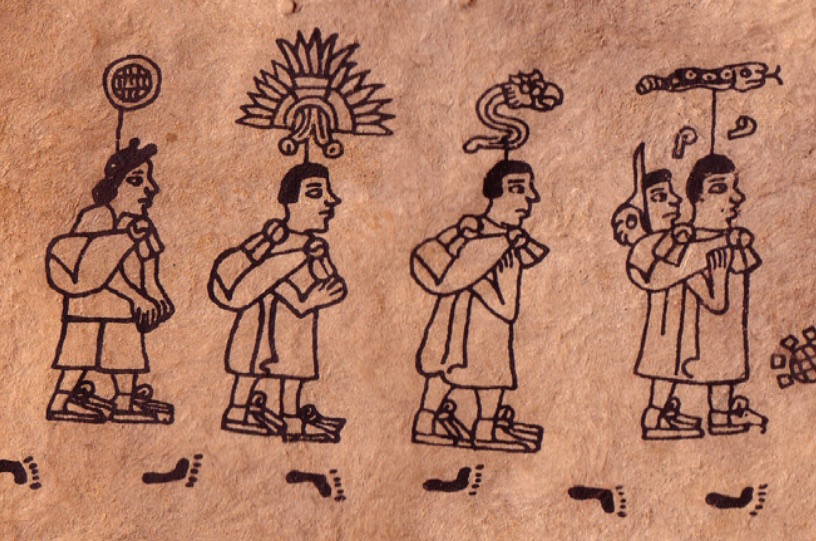ilhuia (TiraP/eg1)
This iconographic detail from the Tira de la Peregrinación or Codex Boturini is a black-line drawing showing a man on the migration from Aztlan to Tenochtitlan. On his back he is carrying the sacred bundle containing the deity Huitzilopochtli. The anthropomorphic head of the deity emerges from the open beak of the diagnostic sign of the hummingbird (huitzilin). In turn, the head of the hummingbird is showing at the top of the sacred bundle, and it is located on the left (opochtli). Crucially, two speech scrolls emerge from Huitzilopochtli involving what James Maffie (personal communication 1/24/2023) would say represents the verb ilhuia, to consult with oneself or with another. The deity seems to be counseling the man (and the group following him, which appears in the contextualizing image below) about the migration.
Stephanie Wood
James Maffie (personal communication, 1/24/2023) shared this example with me, explaining how people and deities conversed. Hence, I am giving this record the title ilhuia, the verb to consult with oneself or with another. The implication is that Huitzilopochtli is giving the group some council about leaving Aztlan. For more information see: Patrick Johansson K., "Tira de la Peregrinación," Arqueología Mexicana Special Issue no. 26 (December 2007). See also Mexicolore's piece on this codex, with a video featuring the work of Gilbert Estrada (2002).
Speech scrolls emerge in various forms, representing human conversations and songs, deities' counsel, and animal sounds. A bell (coyolli) in this collection has sound scrolls coming out of it. Perhaps it is a counseling wind that emerges from the mouth of Ehecatl in the Codex Quetzalecatzin. Opposing speech scrolls captured in book form (tlacuilolli) suggest a two-way conversation or orality in written form (as suggested by Maffie and Mikulska). Trees emit speech scrolls, but those are meant as rebuses (nahuatl, language, for -nahuac, nearby), employing homophonic pairings. This database will be tracking the variety of scrolls, which, in their swirling, also represent a movement of sound.
Between 1530 and 1541.
Stephanie Wood
speech scrolls, volutas, deidades, deities, consultas, conversación, lágrimas
María Castañeda de la Paz, "La Tira de la Peregrinación y la ascendencia Chichimeca de los Tenochca," Estudios de Cultural Náhuatl 38 (2009).
We are reproducing less than 10% of the material in the source article. Furthermore, the original manuscript is of a date that falls outside of copyright.







